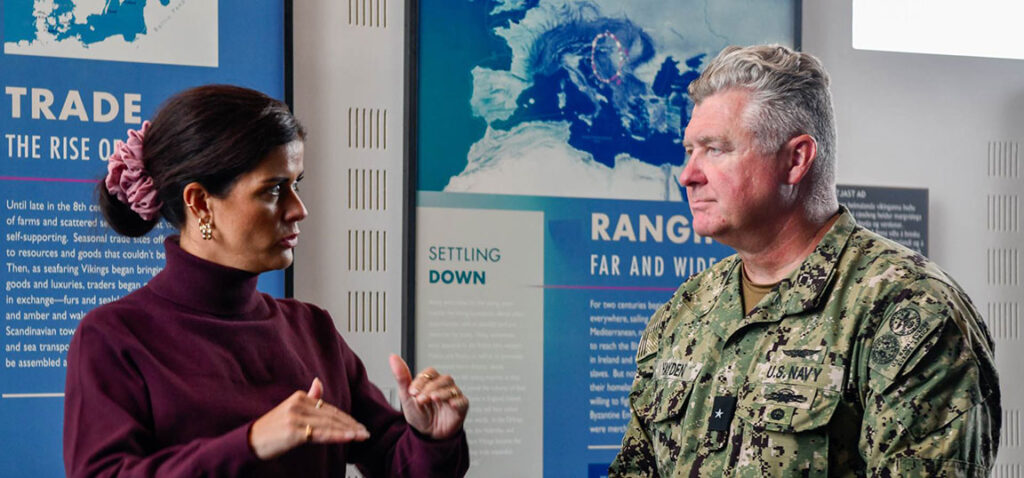Iceland Minister of Foreign Affairs Thordis Kolbrun Reykfjoro Gylfadottir talks with Rear Adm. Patrick Hayden of the U.S. Naval Forces Europe-Africa, U.S. 6th Fleet, during the annual NATO exercise Northern Viking. GOVERNMENT OF ICELAND
THE WATCH STAFF
About 1,200 personnel from nine NATO-member navies performed a complex set of maritime operations to defend Iceland from a simulated attack over an 11-day period beginning in August 2024. The operations demonstrated the interoperability of the naval forces and honed advanced surveillance and deterrence techniques in a highly contested, critically important sea passage known as the GIUK Gap, an acronym for Greenland, Iceland and the United Kingdom. The sea-lanes are a key chokepoint between the Arctic and Atlantic oceans and have assumed heightened importance as the People’s Republic of China (PRC) and Russia have increased their presence and cooperation in the region.
The annual Northern Viking exercise is designed to defend vital underwater communication infrastructure and the surrounding sea-lanes. The operation, which ran from August 24 to September 3, was led by U.S. Naval Forces Europe with participation from Denmark, Iceland, France, Germany, the Netherlands, Norway, Poland and Portugal. Northern Viking included anti-surface, anti-submarine warfare, maritime surveillance as well as search and rescue operations. “Allies deployed an array of drones, maritime patrol aircraft, surface vessels equipped with radars and sensors as well as ships from NATO’s Standing Maritime Group One, part of the alliance’s high readiness maritime capability,” an Allied Maritime Command news release stated. The exercise was further aimed at “facing traditional military threats on land, at sea and in the air, but also multi-faceted threats and acts of sabotage, which will test the Icelandic authorities.”
The GIUK Gap’s communication and transit links between North America and Europe underscore its importance for NATO. In recent years, a rash of sabotage of Arctic and European infrastructure has concerned NATO members, several of whom have linked such activities to Russian-sponsored actors, according to The New Yorker magazine. Those activities, including the deliberate cutting of undersea cables and communication links, have clarified the stakes for NATO. “Ensuring the security and freedom of navigation in this area is essential for both NATO’s collective defense strategy and for maintaining global maritime security,” the news release stated. “In a region that is a focal point for geopolitical competition, maintaining robust surveillance capabilities is essential for early warning and rapid response to potential threats.”
Just two days before the exercise began, PRC Premier Li Qiang met with Russian President Vladimir Putin in Moscow in an apparent strengthening of their recent Arctic cooperation. A communique released by China’s State Council after the meeting highlighted that the Arctic is an area where the two partners want to expand their collaboration specifically related to “shipping development, navigation safety, polar ship technology and construction,” according to Defense News, a military affairs website.
NATO naval vessels taking part in Northern Viking included the Portuguese frigate Dom Francisco de Almeida, the German tanker Rhoen, the French frigate Aquitaine and the Dutch light cruiser De Ruyter, all of which are part of the Standing NATO Maritime Group One, according to the release. The ships carried state-of-the-art surveillance and communication equipment. “The exercise provided a valuable opportunity for NATO Allies to demonstrate and refine their ability to conduct coordinated surveillance and reconnaissance operations, crucial for monitoring the vast maritime expanse and ensuring situational awareness,” the release stated.

